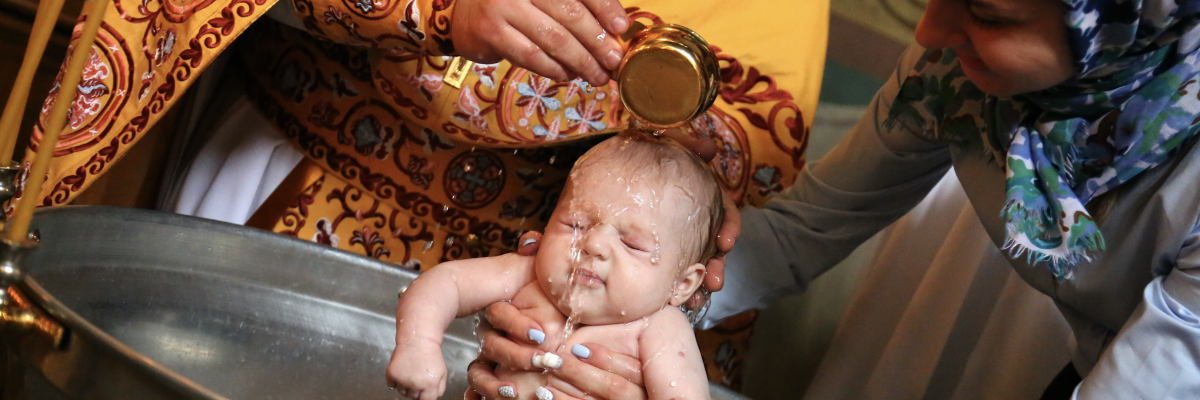
I recently received an email from a former Catholic who was livid that the Church baptized by pouring water rather than (according to her) the only biblical, and therefore valid, way: immersion. Pointing out that that the Greek word baptizo means “to immerse,” she advised me to “get out of that dead Catholic Church and get right with God!”
Let’s clear this up. In the Catholic Church, there are three forms of baptism that are considered valid: immersion, pouring, and sprinkling, the last of which is commonly referred to as baptism by aspersion. Among the three valid forms, aspersion is not permitted in the Church today, but it is considered valid. In legal terms, we would say baptism by aspersion is valid but not licit (permitted). Immersion and pouring are both valid and licit.
Baptism is a staple of the Faith, so does my Protestant friend make any valid points here? Well, obviously not when it comes to everybody leaving the Church Jesus established. But what about her point about baptism by immersion?
Let’s take a look.
There are at least three reasons why my new friend’s immersion-only argument is unbiblical.
1. The Greek word, baptizo, does not only mean “to immerse”
Barclay M. Newman’s A Concise Dictionary of the New Testament defines baptismos, which possesses the same root as the verb, baptizo, but in the form of a noun: “ritual washing, ablution, baptism; washing (of hands).” This definition would certainly include full immersion. But the “ritual washing” and “washing (of hands)” part of the definition would also include the kinds of washing we see in the Bible. For example, in Deuteronomy 21:6 where the elders of a city were commanded to wash their hands over a heifer as part of a ritual to purge their land of guilt over a slain person whose killer was undiscovered. This kind of ritual “washing” would be considered just as much a “baptism” as would a “baptism” where someone is entirely immersed.
Also consider Romans 6:3-4:
Do you not know that all of us who have been baptized into Christ Jesus were baptized into his death? We were buried therefore with him by baptism into death, so that as Christ was raised from the dead by the glory of the Father, we too might walk in newness of life.
From a symbolic perspective, immersion better portrays being “buried” with Christ. And that is at least one reason why the Catholic Church teaches immersion to be a valid form of baptism (cf. CCC 628; 1239). But baptizo is not limited to immersion in the New Testament. It can also mean, as Newman points out: “to wash,” as in, the “washing” of hands. In fact, according to Luke 11:37-38, a “ritual washing” and “the washing of hands” can be joined as one:
While [Jesus] was speaking, a Pharisee asked him to dine with him; so he went in and sat at table. The Pharisee was astonished to see that he did not first wash (Gr. ebaptisthe, aorist, third person singular form of baptizo) before dinner.
This was obviously not immersion. There were “baptisms” the Pharisees did that would involve full immersion, but this was not one of them. Mark 7:3-4 gives us an even more complete picture of the nature of the “baptism” being referred to here: “For the Pharisees, and all the Jews, do not eat unless they wash their hands. . .” The Greek word used here for wash is ebaptisthe, or “baptize.”
Moreover, Jesus prophesied that with the coming of the Holy Spirit at Pentecost, the apostles would be “baptized with the Holy Spirit” (Acts 1:5), and yet its fulfillment in Acts 2:4 is described in two distinct ways, neither of which indicating “immersion.” In Luke 24:49, for example, we find this same “baptism in the Holy Spirit” referred to as being “clothed” upon:
And behold, I send the promise of my Father upon you; but stay in the city, until you are clothed with power from on high.
To be “clothed” does not indicate an immersion; rather, a partial covering. And yet, this is clearly baptism in the Holy Spirit.
And as an aside here, would not pouring be a better symbol for “baptism” in this instance than immersion would be? Just sayin’. . .
We should also look at Acts 2:16-17 where we read:
But this is what was spoken by the prophet Joel: “And in the last days it shall be, God declares, that I will pour out my Spirit upon all flesh, and your sons and your daughters shall prophesy.”
Could the “baptism in the Holy Spirit” of which Jesus speaks also be understood as being “immersed” in the Holy Spirit? Yes, it could. But as Catholics we are bound by God’s word. This biblical text describes the Holy Spirit being “poured out” upon the recipients of this great gift. Thus, it would be unbiblical to claim that “baptism” can only refer to immersion.
We also have a very telling prophecy from the Old Testament that must be brought to bear in any discussion of baptism:
I will sprinkle (Heb. zaraq) clean water upon you, and you shall be clean from all your uncleanness, and from all your idols I will cleanse you. A new heart I will give you, and a new spirit I will put within you; and I will take out of your flesh the heart of stone and give you a heart of flesh. And I will put my spirit within you, and cause you to walk in my statutes and be careful to observe my ordinances.
This text, it is certain, is speaking of the coming of the New Covenant and the cleansing power of the Holy Spirit that would come with its advent. Reminiscent of Ananias’s call to St. Paul, “[A]rise, and be baptized, and wash away your sins” (Acts 22:16) or Jesus’ proclamation, “He that believes and is baptized shall be saved,” how could one not see a fulfillment in baptism here? And, at the same time, how could someone not see the possibility of baptism by something other than immersion as well?
2. How did Jesus and the New Testament ministers baptize?
What about the claim that “Jesus was immersed,” as was “the Ethiopian Eunuch” in Acts 8? Actually, these arguments represent two very common missteps among Protestants.
Let’s examine Jesus’ baptism first:
Then Jesus came from Galilee to the Jordan to John, to be baptized by him. John would have prevented him, saying, “I need to be baptized by you, and do you come to me?” But Jesus answered him, “Let it be so now; for thus it is fitting for us to fulfill all righteousness.” Then he consented. And when Jesus was baptized, he went up immediately from the water, and behold, the heavens were opened and he saw the Spirit of God descending like a dove, and alighting on him; and lo, a voice from heaven, saying, “This is my beloved Son, with whom I am well pleased” (Matt. 3:13-17).
Many assume that when the text says that “he went up immediately from the water,” it means that he was first under the water and then came up from under the water, and that this constituted his baptism. But that is not what the text says: it says Jesus was baptized and then he came up from, or out of the water. The text is silent as to the mode of baptism St. John the Baptist used.
As a practical matter, it would seem St. John did not immerse Jesus. Anyone who has been to the Holy Land and has been to “Bethany beyond the Jordan” (John 1:28) where Jesus is believed to have been baptized knows that the water there would have been about knee-high. This is likely why the ancient works of art depicting this sacred event present St. John as pouring water on our Lord’s head.
Similarly, when it comes to St. Philip baptizing the Ethiopian eunuch, we find:
And as they went along the road they came to some water, and the eunuch said, “See, here is water! What is to prevent my being baptized?” And he commanded the chariot to stop, and they both went down into the water, Philip and the eunuch, and he baptized him. And when they came up out of the water, the Spirit of the Lord caught up Philip; and the eunuch saw him no more, and went on his way rejoicing (Acts 8:36-39).
Just as the case of our Lord’s baptism, the text itself is unclear. Philip and the eunuch “went down into the water.” Philip baptized him. And then they came up from the water. It simply does not tell us the manner in which the eunuch was baptized.
3. History confirms the Catholic practice
The Didache, dated to the first century by most modern scholars is of enormous value because in it we see a first-century catechism for catechumens which was most likely penned before all of the books of the New Testament were even written. And what do we find concerning baptism?
Concerning baptism, baptize in this manner: . . . baptize in the name of the Father and of the Son and of the Holy Spirit in living water. If there is no living [“running”] water, baptize in other water; and, if you are not able to use cold water, use warm. If you have neither, pour water three times upon the head in the name of the Father, Son, and Holy Spirit (7:1).
St. Hippolytus (A.D. 215) is unclear as to which manner of baptism he prefers. He appears to recommend immersion but makes it clear that immersion is not essential to the sacrament when he says:
If water is scarce, whether as a constant condition or on occasion, then use whatever water is available (The Apostolic Tradition).
Pope Cornelius (A.D. 251) writes in very plain terms, in his Letter to Fabius of Antioch:
As [Novatian] seemed about to die, he received Baptism in the bed where he lay, by pouring.”
Tertullian (A.D. 205), mentions “sprinkling” as a valid form for baptism, even though he evidently (from his writing) preferred immersion:
There is absolutely nothing which makes men’s minds more obdurate than the simplicity of the divine works which are visible in the act, when compared with the grandeur which is promised thereto in the effect; so that from the very fact, that with so great simplicity, without pomp, without any considerable novelty of preparation, finally, without expense, a man is dipped in water, and amid the utterance of some few words, is sprinkled, and then rises again, not much (or not at all) the cleaner, the consequent attainment of eternity is esteemed the more incredible (On Baptism).
St. Cyprian (A.D. 255) responding to a man who was asking him the specific question of whether or not the pouring of water in baptism would be valid:
You have asked also, dearest son, what I thought about those who obtain the grace of God while they are weakened by illness – whether or not they are to be reckoned as legitimate Christians who have not been bathed with the saving water, but have had it poured over them.
In the saving sacraments, when necessity compels and when God bestows His pardon, divine benefits are bestowed fully upon believers; nor ought anyone be disturbed because the sick are poured upon or sprinkled when they receive the Lord’s grace (Letter to a Certain Magnus).
Whether we want to speak of the biblical texts involved in the discussion, the historical first-century context of biblical baptisms, or the era of the Fathers of the Church, it is very clear. Do you dunk? Do you pour? Do you sprinkle? The answer is: all of the above.



